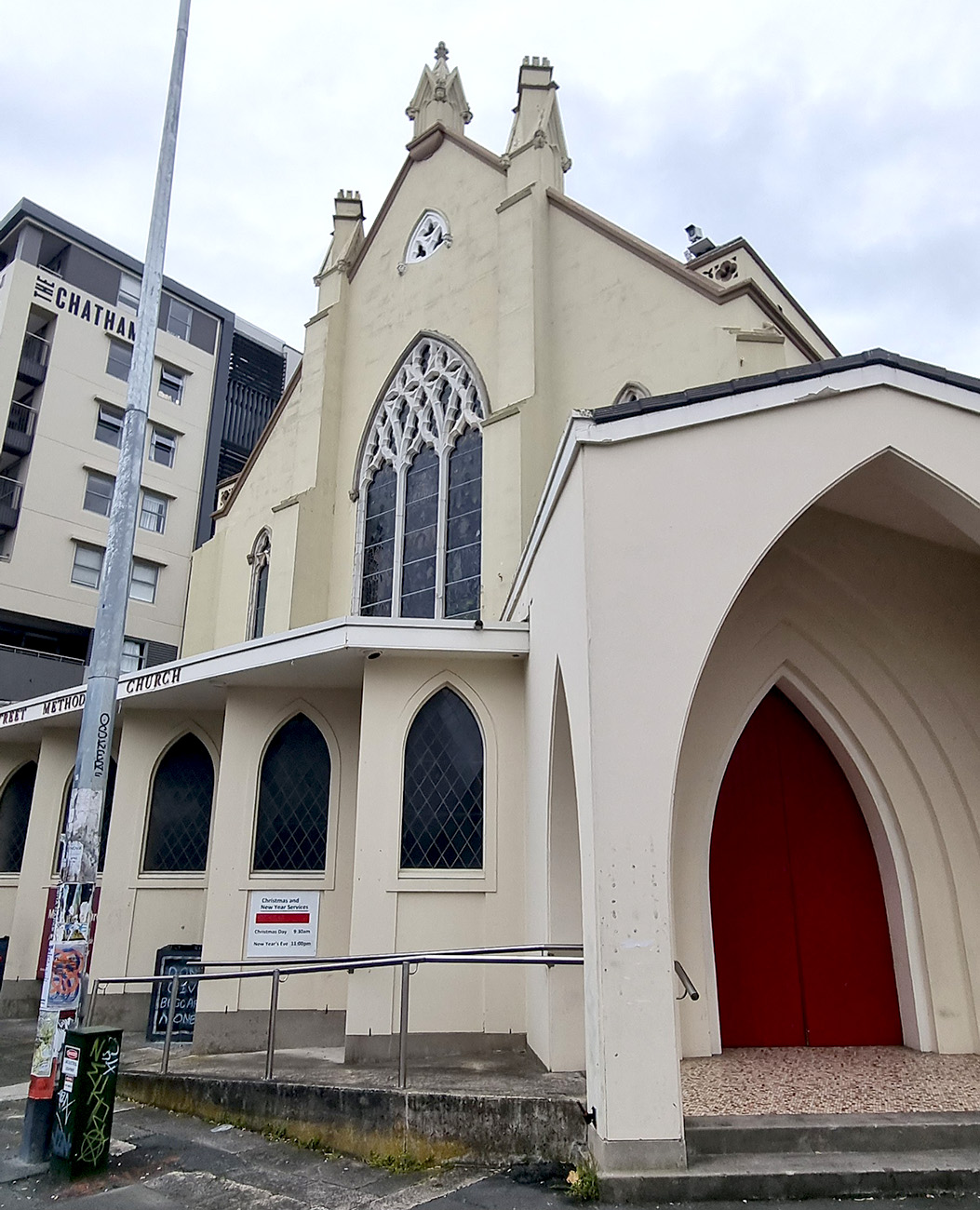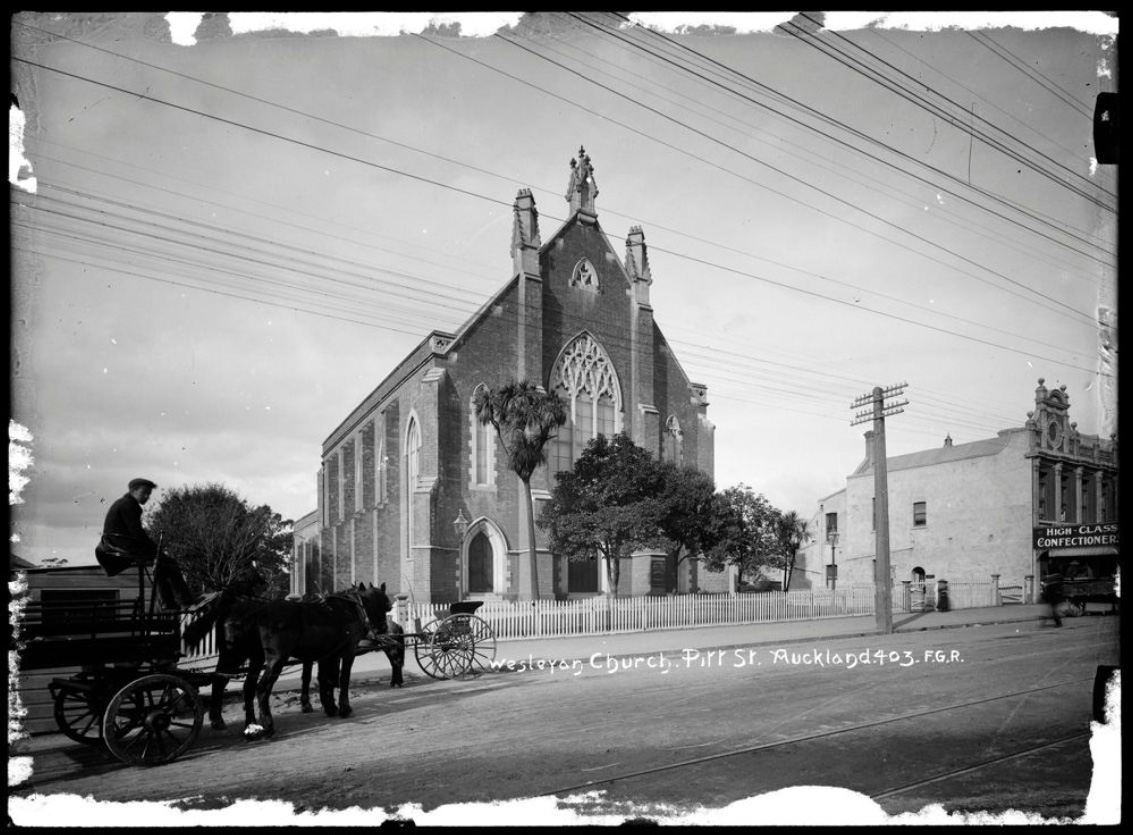Erected in 1865-1866 to accommodate an expanding Methodist ministry in Auckland, the Pitt Street church has been referred to as 'the Cathedral of Auckland Methodism'. The first Methodist gatherings in Auckland were held in 1841, soon after the establishment of the settlement as colonial capital of New Zealand. Early services were conducted in temporary accommodation such as the Supreme Court House in Queen Street and a carpenter's shop in Chancery Street, while a purpose-built timber chapel was erected in High Street in 1843. This place of worship was replaced by a brick structure five years later, and by 1859 expansion had included the construction of another brick chapel on Hobson Street. The New Zealand Wesleyan mission was administered from Auckland from 1843 until 1854, the year the British Methodists created the new Conference of Australasia, which included two New Zealand mission areas. By 1866 the Northern Wesleyan District, of which Auckland was head, included the entire North Island, while the Southern District was administered from Christchurch. Methodism is said to have flourished among early colonists because it had a tradition of using understandable language, and was unpretentious and democratic. From the 1840s until 1900, about ten percent of New Zealand's population were Methodist. The faith remains the country's fourth largest religious denomination. In 1864, a one-acre site was purchased in Pitt Street for the express purpose of building a "large chapel". While the traditional centre of Auckland Methodism in High Street lay in the commercial heart of the settlement, the new site overlooked the town from a prominent position on the skyline. The structure was planned as an impressive and ornate building, contrasting with the plainer appearance of earlier nonconformist chapels. There are indications that its use of Gothic Revival, an architectural style more closely associated with the Anglican Church, may have been controversial. The foundation stone for the church was laid in November 1865 by Thomas Russell (1830-1904), a member of the High Street congregation and acknowledged leader of Auckland's business community, who was instrumental in the foundation of the New Zealand Insurance Company and the Bank of New Zealand. Estimated to have involved an outlay of about £11,000, the cost of the church exceeded initial expectations and its design was modified accordingly. The church was claimed in 1865 as being second only in New Zealand to Christchurch's Durham Street Wesleyan Church, which was also under construction. The Pitt Street Church's striking brick and stone exterior incorporated numerous stone heads, believed to have been executed by the renowned carver and engraver Anton Teutenberg (1840-1933). The church was designed by Philip Herapath (1822-1892), who was subsequently responsible for a number of other nonconformist buildings in the Auckland area, including Wesleyan chapels at Onehunga (1877), Pukekohe (1878) and Pokeno (1878), and the Beresford Street Congregational Church (1874-1876), a pioneer in concrete design. The church opened for use on 14 October 1866, with room for 650 individuals. It incorporated a large schoolroom in its basement, while the main church interior followed the 'preaching hall' tradition of nonconformist worship, containing a large gallery for the choir and Sunday School children who required supervision during the service. The church's first minister was James Buller (1812-1884), who had earlier been a missionary at Mangungu Mission Station in the Hokianga and who had carried out the earliest official Methodist services in Auckland in September 1841. The leader of the Hokianga Mission, John Hobbs (1800-1883), became a member of the Pitt Street congregation while living at nearby Beresford Street, and his funeral was held at the church after his death in 1883. Other missionaries to follow Buller in his role as minister included Alexander Reid and William Kirk. After the closure of the High Street chapel in 1874, the Pitt Street structure effectively became the leading church in the Northern District. Plaques honouring other notable Methodist missionary pioneers, such as John Bumby (1808-1840) and John Skevington (?-1845), were transferred from the High Street site. Rents for use of the pews helped to reduce the large debt that the church had incurred during construction work. With a growing local population during the boom years of the 1870s and early 1880s, the Auckland Circuit headed by the Pitt Street church provided the initiatives, money and workforce for the expansion of chapels into developing areas. Influenced by the work of Wesleyans in Great Britain, laymen in the Pitt Street church also fostered the Helping Hand Mission, which met in halls in the poorer areas of the parish as part of an evangelical revival. With the enhanced role of the church, plans to construct internal side galleries in accordance with the original design were completed in 1877. A large hall was also opened directly next to the church for adult Sunday School classes, while a new parsonage was built on the site of an earlier brick structure fronting Karangahape Road. Children's classes continued to be held in the basement of the chapel. For some time the Pitt Street establishment was regarded as a model school. Further expansion of the Pitt Street church occurred in 1887, with a two-storeyed addition at its eastern end. Possibly modelled on Herapath's initial design, it contained a lecture hall and classrooms in its basement area, and a 'church parlour', choir vestry and classrooms above. Each Annual New Zealand Wesleyan Conference that met in Auckland was held at Pitt Street, and in 1897 the church hosted the General Conference of Australasia. The nineteenth-century congregation included prominent local businessmen, such as the Wilson brothers (proprietors of the New Zealand Herald) and William and George Winstone (general carriers and quarriers), as well as members who were active in new initiatives for women, such as Eliza White and Annie Schnackenberg. Joseph Liston Wilson headed one of the earliest petitions to Parliament on the issue of women's suffrage, while Eliza White started the Ladies' Christian Association in 1875, which was later converted in the Auckland Branch of the Young Women's Christian Association (YWCA). Schnackenberg was national president of the Women's Christian Temperance Movement (WCTU) in 1893, when New Zealand women were granted the vote. Prominent visitors included Sir William Fox, who gave an address on the responsibility of the Christian church in relation to the liquor trade in 1887, Herbert Booth of the Salvation Army, and the chaplains of the British and American Fleets in 1924 and 1925 respectively. The Prince of Wales (later Edward VIII) also attended service there in 1920, while Queen Salote of Tonga is said to have attended the church regularly while in the city. The radio celebrity 'Uncle Tom' - Tom Garland (1877-1964) - a founder of the innovative 'Friendly Road' radio church in Auckland in the 1930s, was in charge of Sunday School music at the church and later became a trustee. Internal alterations to the church during the twentieth century have included modifications to the position of the organ and pulpit, and the addition of a number of memorial windows. In 1962 more significant changes were carried out to the front of the building, when a single-storey vestibule was added and the internal side galleries were removed. Changes to the surrounding site, owned by the church trustees, have included the construction of a row of shops on the Karangahape Road corner in 1904, and the replacement of the earlier timber hall by the three-storeyed Bicentennial Wesleyan Hall in 1939. The church continues to serve as an important place of worship in the inner city, with ongoing Sunday School programmes and Youth Groups. Over the past few decades, the church has had significant links to several of Auckland's ethnic groups, including the Samoan, Tongan and Korean communities.




Location
List Entry Information
Overview
Detailed List Entry
Status
Listed
List Entry Status
Historic Place Category 2
Access
Private/No Public Access
List Number
626
Date Entered
6th June 2005
Date of Effect
6th June 2005
City/District Council
Auckland Council
Region
Auckland Council
Extent of List Entry
The registration includes part of the land in RT NA597/52 (as shown on Map C in Appendix 4) and the church, its fittings and fixtures thereon. The area of registration extends one metre beyond the outer edge of the external wall of the structure.
Legal description
Part of Pt Allot 34 and Allot 33 Sec 29 Town of Auckland (RT NA597/52)
Stay up to date with Heritage this month
